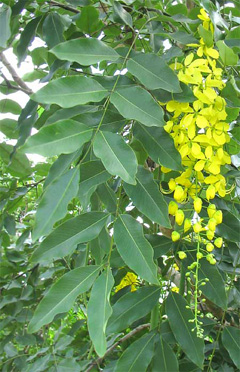Table of Contents
- Basonym of Drug
- Classification of the Dravya
- Properties and actions
- RASA PANCHAKA :
- DOSHA KARMA.
- Rogaghnata (Therapeutic indications)
- Amayika prayoga (Therapeutic administration)
- Matra (Dose)
- Important phytoconstituents
- FORMULATIONS & Indication
- Habitat
- Research Corner:
- Gallery
- Read other articles
Basonym of Drug
आ समन्ताद् रुजां वधोऽत्र ।
Aragwadha completely cures ailments.
Botanical Name: Cassia fistula Linn.
Cassia-Kasia (Greek), derived from a Hebrew word, which is a name of plant.
fistula-Tube (Refering to the cylindrical pod)
Family-Fabaceae (See appendix-II for family features).
Classification of the Dravya
Charaka
Kushthaghna, Kandughna Varga
Sushruta
Aragwadhadi gana, Shyamadi gana
B.P.Ni.
Haritakyadi varga.

- कृतमाल-कृता धारिता माला पुष्पाणामनेन ।
When flowering, the tree looks adorned with garlands.
- चतुरङ्गुल-चतस्त्रोऽङ्गुल्यः प्रमाणमस्य पर्वणः, चतुरङ्गलमितानि फल-मज्जपर्वणी इत्यर्थः ।
Aragwadha fruit has depression at every 4 inch distance.
- दीर्घफलः दीर्घ फलं यष्टिवदस्य ।
Aragwadha fruits are long.
- राजवृक्षः वृक्षाणां राजा, सुमनः शेखरत्वात् ।
Aragwadha tree is regarded as king of tree oving to its beauty.
- स्वर्णाङ्ग-स्वर्णवर्णान्यङ्गानि पुष्पाण्यस्य ।
Aragwadha flowers are golden yellow coloured.
- प्रग्रहः– प्रकर्षेण गृहाते जनैः ।
Aragwadha tree is liked by people as it is beautiful.
Properties and actions
- आमहा-आमं हन्ति ।
Aragwadha relieves Ama
- आरेवत-आरेवयति निःसारयति मलम् ।
Expels mala (faeces) from the body.
- आरोग्यशिम्बि-आरोग्यप्रदः शिम्बः फलमस्य ।
Pods are therapeutically very useful.
- कुष्ठसूदन-कुष्ठं सूदयतीति ।
Aragwadha cures skin diseases.
- ज्वरान्तकः ज्वरनाशकः ।
Aragwadha relieves from fever.
- व्याधिघातः व्याधीन् हन्ति ।
Aragwadha is useful in many diseases.
- शम्पाकः-शं कल्याणकारी पाकोऽस्य ।
Others
Aragwadha corrects the digestive process.
- कर्णाभरणः-कर्णयोराभरण हृपेण प्रयुज्यते ।
Aragwadha flowers were used as ear ornaments.
RASA PANCHAKA :
| Rasapanchaka | Phalamajja | |||
| Rasa | Madhura, Tikta | |||
| Guna | guru, snigdha | |||
| Virya | sita | |||
| Vipaka | madura |
DOSHA KARMA.
Karma (Actions)Phala (Fruit) – Sramsana, Shulahara, Ruchya, Koshtha Shuddhikara, Krimighna, Pramehaghna, Jwaraghna, Kushtaghna
Patra (Leaf)-Meda vishoshaka, Virechaka.Pushpa (Flower) – GrahiAragwadha phala majja is best Sramsaka.
Dosha karma :Vatapitta Shamaka and Pitta kapha samshodhaka.Vata Shamaka because of Madhura rasa, Snigdha guna and Madhura vipaka.Pitta Shamaka because of Madhura rasa and Shita virya.Pitta kapha, Samshodhaka because of its Sramsana property.
Agrya Karma
चतुरङ्गलो मृदु विरेचनानाम् । (च.सू. 25/40)Chaturangula (Cassia fistula Linn.) induce mild purgation
Pharmacological actions
• Purgative• Feverish
Rogaghnata (Therapeutic indications)
Phala (Fruit)-Jwara, Hradroga, Raktapitta, Udavarta, Kushtha Krimi Prameha, Mutrakrachra, Gulma, Udara, Vrana.
Patra (Leaf) Medoroga
Amayika prayoga (Therapeutic administration)
- Prameha (Diabetes insipidus)
हरिद्रा मेहिनं राजवृक्षकषायम् । (सु.चि. 11/9)
Aragwadha (Cassia fistula) kashaya is best for Haridra meha.
- Kushtha (Skin diseases)
पर्णानि पिष्ट्वा चतुरङ्गुलस्य तक्रेण पर्णान्यथ काकमाच्याः । तैलक्तगात्रस्य नरस्य कुष्ठान्युद्वर्तयेद्वहनच्छदैश्च ।। (च.सू. 3/17)
Triturate leaves of Aragwadha (Cassia fistula) and Kakamachi (Solanum nigrum) with buttermilk. The paste thus obtained is applied over skin lesions (the part should be anointed prior to this application).
- Amavata (Rhumatoid arthritis)
आरग्वधस्य पत्राणि भृष्टानिकटुतैलतः । आमघ्नानि नरः कुर्यात् सायं भक्तावृताति च ॥ (भा.प्र.चि. 26/52)
Leaves of Aragwadha (Cassia fistula) are fried with mustard oil. These leaves are chewed after evening meal.
- Visarpa (Erysipelas)
आरग्वधस्य पत्राणि त्वचं श्लेष्मातकस्य च। पृथगालेपनं कुर्यात् द्वन्द्वशः सर्वशोऽपि वा । प्रदेहाः सर्व रावैते देयाः स्वल्पघृताप्लुताः ।। (च.चि. 21/89-92)
Paste of Aragwadha (Cassia fistula) leaves and Shleshmataka bark is mixed with ghee and applied in all types of Visarpa (Erysipelas).
Matra (Dose)
Bija churna (Powder);3_6 g
Mula twak kwatha;10-15ml
Pushpa swarasa 5-10 ml
Phala majja (Fruit pulp) 10 to 20 g
Important phytoconstituents
Pod pulp – Anthraquinone, sucrose, lignoceric acid, amino acids.
Root bark – Anthraquinone derivates, sennoside A&B, Fistucacidin, g-sitosterol, Volatile oil.
Stem bark and Leaves – Rhein glycoside.
Rogaghnata (Therapeutic indications)
Phala (Fruit)-Jwara, Hradroga, Raktapitta, Udavarta, Kushtha Krimi Prameha, Mutrakrachra, Gulma, Udara, Vrana
FORMULATIONS & Indication
Aragwadhadyarista- jwara, hrdroga, vatarakta
Aragwadhadi Avaleha-Udavartha, hrdroga
Aragwadhadi ghrta- jwara, vatarakta
Aragwadhadi kashaya-sula, kamala, raktapitta
Aragwadhadi taila- switra
Mahamarichyadi ttaila-kustha, sarvanga, sotha.
Habitat
Grows all over India and as it is a beautiful plant, it is cultivated in gardens.
External Morphology
Habit-A medium sized perennial tree.
Stem-Erect, branched, cylindrical, woody, solid, bark greenish grey in colour.
Leaf-Alternate, petiolate, compound, paripinnate, with pulvinus base, leaf lets 4-8 pairs, stalked, ovate, wavy, acute, glabrous, entire, venation of the leaflets unicostate, reticulate.
Inflorescence-Long axillary pendulous racemes.
Flower Pedicellate, with long pedicels, bracte- ate, bisexual, complete, zygomorphic, yellow, hypogy- nous and pentamerous.
Calyx-5 speals, slightly petaloid, polysepalous, odd sepal anterior, imbricate aestivation
Corolla-5 petals, polypetalous, yellow, posterior
petal is the small and innermost in the bud; petals unequally inserted on the thalamus.
Androecium-10 stamens, polyandrous and all with anthers, but very unequal in length.
Gynoecium-Monocarpellary, ovary superior, unilocular, with marginal placentation, ovules many, short style, stigma is terminal and hairy.f
Fruit-A legume which is very long (1-2 feet) and cylindrical (nearly one inch in diameter).
Seeds-Flat, albuminous, embedded in soft pulp.
Varieites :
Dhanvantari Nighantu & Raja Nighantu: 1. Aragwadha 2. Karnikara
Research Corner:
- Cassia fistula stem bark was used for the preparation of aqueous extract and synthesis of god nanoparticles to evaluate the hypoglycemic effects and found that gold nanoparticles have promising antidiabetic properties. (Daisy P, Saipriya K. Biochemical analysis of Cassia fistula aqueous extract and phytochemically sythesized gold nanoparticles as hypoglycemic treatment for diabetes mellitus. Int. J. Nanomedicine. 2012;7:1189-202. Epub 2012 Mar 7).
- Antibacterial and antifungal potentials of hydroalcohol extracts of leaves of Cassia fistula Linn found very effective. (Bhalodia NR, Shukla VJ. Antibacterial and antifungal activities from leaf extracts of Cassia fistula L.: An ethnomedicinal plant. J Adv Pharm Technol Res. 2011 Apr, 2 (2):104-9).
- Bioactivity-guided fractionation of n-hexane phase from MeoH extract of the seeds of Cassia fistula L. (Leguminosae) yielded two bioactive substances against Cladosporium cladosporioides and C. sphaerospermum. (Sartorelli P. Lago JH, Cunha RL, Kitamura RO, Young MC. A new minor dimmeric ester from seeds of Cassia fistula L. (Leguminosae). Nat Prod Res. 2012;26(1):36- 41. doi: 10.1080/1478619.2010.5321128. Epub 2011 Jul 15).
- Methanolic extract of seeds of Cassia fistula did not produce any significant toxic effect in mice. (Jothy SL, Zakaria Z, Chen Y, Lau YL, Latha LY, Sasidharan S. Acute oral toxicity of methanolic seed extract of Cassia fistula in mice. Molecules. 2011. Jun 23;16(6):5268-82).
- Cassia fistula fruit pulp and seed extract possessed anticandidal activity. (Irshad, Shreaz S, Manzoor N, Khan LA, Rizvi MM. Anticandidal activity of Cassia fistula and its effect on ergosterol biosynthesis. Pharm Biol. 2011 Jul; 49(7):727-33. Epub 2011 May 18).
- Crude hydro-alcoholic extract of Cassia fistula (golden shower tree) fruit to protect the kidney against bromobenzene-induced toxicity was confirmed by the histological examination of the kidneys. (Kalantari H, Jalali M, Jalali A, Salimi A, Alhalvachi, F, Varga B, Juhasz B, Jakab A, Kemeny-Beke A, Gesztelyi R, Tosaki A, Zsuga J. Protective effect of Cassia fistula fruit extract on bromobenzene-induced nephrotoxicity in mice. Hum Exp Toxicol. 2011 Oct; 30(10:1710-5. Epub 2011 Jan 19).
- Hepatoprotective an antioxidant activities of ethanolic leaf extract (ELE) of Cassia fistula Linn. against diethylynitrosamine induced liver injury in ethanol pretreated rats was found very effective. (Pradeep K, Raj Mohan CV, Gobianand K, Karthikeyan S. Protective effect of Cassia fistula Linn. on diethylinitrosamine induced hepatocellular damage and oxidative stress in ethanol pretreated rats. Biol Res. 2010;43(1):113-25. Epub 2010 May 7)
Gallery
FRUIT OF ARAGWADA.

FLOWER OF ARAGWADA.

LEAF OF ARAGWADA

Read other articles
- Global Perspectives on Folliculitis: Ayurveda’s Approach to Prevention, Treatment, and Healthcare Disparities
- How to Lose Weight in 1 Week: Ayurvedic and Research-Based Insights
- 50 Research Paper Insights into Sleep: The Ultimate Guide to Health, Cognitive Performance, and Longevity
- Top 20 Most comely Useful Instruments in Physiology lab with their classification- part 4
- BEST AYURVEDIC DIET AND NUTRITION GUIDE
- AYURVEDA INTRODUCTION
- Growth of the Ayurveda Wellness Market in 2024: Personalization, Technology, and Global Expansion
- Shat Kriyakala: Understanding 6 Stage of Disease Progression in Ayurveda and Its Modern Relevance
- Understanding Concepts 3 Doshas in Ayurveda: Tridosha
- Anatomy, Function, and Clinical Insights into the Mediastinum: A Comprehensive Overview







